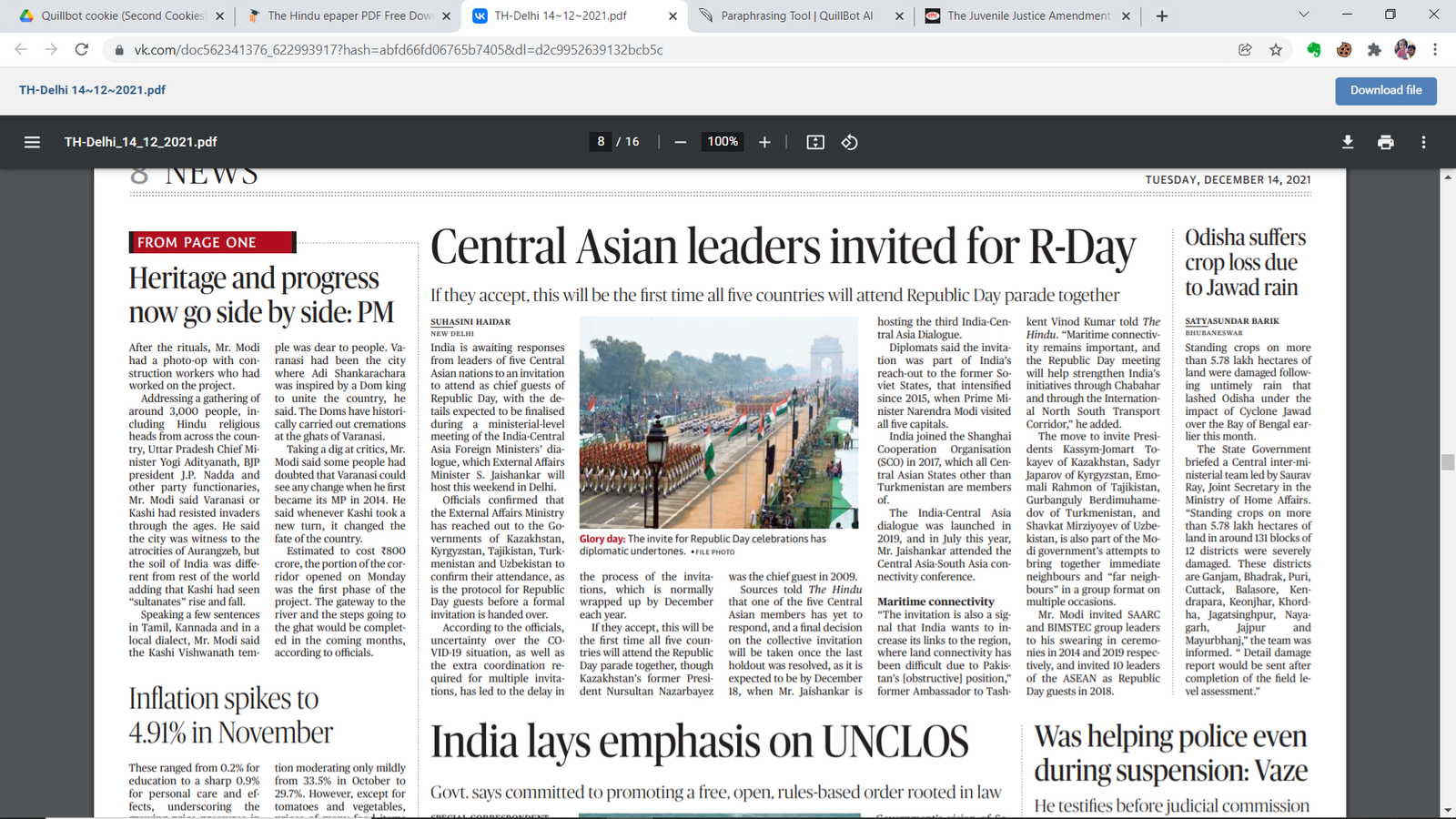
Prepare IAS Coaching
Current Affairs

Title : RELATIONS BETWEEN INDIA & CENTRAL ASIAN COUNTRIES
Date : Dec 15, 2021
Description :
RELATIONS BETWEEN INDIA & CENTRAL ASIAN COUNTRIES:
Based on a News Article published in the ‘The Hindu’ on 14th December 2021 on Page Number 8
Useful for UPSC CSE Prelims and Mains (GS Paper II)
Context:
- Kazakhstan, the Kyrgyz Republic, Tajikistan, Turkmenistan, and Uzbekistan make up the Central Asia area (CA). India was one of the first countries to acknowledge the five nations of Central Asia. India established diplomatic relations with them after achieving independence in the 1990s.
- India currently views the Central Asian countries to be part of its "extended and strategic neighbourhood."
- Trade between India and the five Central Asian countries is currently worth roughly $2 billion.
- They were chosen as a gateway to China's Silk Road Economic Belt (SREB) programme because their cost was less than China's estimated $50 billion.
The importance of Central Asia:
- Geographically, these countries are positioned as a bridge between Asia's numerous regions, as well as between Europe and Asia.
- With the implementation of the Chabahar Agreement with Iran, new commercial routes between India and Central Asia have been established, bypassing Pakistan.
- Farkhor is India's only foreign military airbase, which is shared by the Indian Air Force and the Tajik Air Force (Tajikistan).
- The CARs share borders with China, Afghanistan, Russia, and Iran. Tajikistan shares a border with Pakistan-controlled Kashmir (PoK).
- Energy security:
- Central Asian countries are geographically comparable to India and have significant hydrocarbon and mineral resources. As an example,
- Kazakhstan is the world's greatest producer of uranium and has significant gas and oil reserves.
- Uzbekistan, along with Kyrgyzstan, is a major regional gold producer.
- Tajikistan has a lot of hydropower potential, and Turkmenistan has the fourth greatest gas reserves in the world.
- Kazakhstan and Turkmenistan are also on the Caspian shore, proposing to open up the region to other oil-rich Caspian states.
- Security:
- The withdrawal of US forces from Afghanistan would have substantial regional security implications.
- The 'Golden Crescent' illicit drug trade in opium production (Iran-Pakistan-Afghanistan) poses a huge threat to CARs, who are also victims of the illicit weapons trade. Instability in Central Asia has the potential to spread to Pakistan
- Furthermore, religious extremism, fanaticism, and terrorism continue to threaten Central Asian societies as well as regional stability.
- Economic expansion in Central Asia, particularly in Kazakhstan, Turkmenistan, and Uzbekistan, has triggered a construction boom, and sectors such as IT, pharmaceuticals, and tourism have been increasing. India has experience in many industries, and a stronger partnership will offer economic relations with these countries a boost. Indian medicinal products are also in high demand in the region.
India's challenges include the following:
- Landlocked region: Because it is landlocked, the interaction between India and Central Asia has been hampered. Weak connection has also resulted in subpar trade between India and Central Asia.
- Furthermore, India has no physical borders with any of the Central Asian states.
- There is a significant bottleneck in fostering and expanding economic, commercial, electricity, and tourist links with them.
- The historic Silk Road was one option, but the security situation in Xinjiang, unsolved border conflicts with China, and protracted discussions led India to seek alternative routes to the CARs.
- India has been deprived of the benefits of Central Asian ties due to the unstable situation in Afghanistan and Pakistan's geostrategic importance in the region.
- Central Asia is included in the Silk Road Economic Belt (SREB) plan, which is led by China. Furthermore, the threat posed by Islamic extremism spreading to the Uighurs in Xinjiang region has pushed China to become deeply involved in Central Asian security concerns, harming India's interests indirectly.
- Radicalism and extremism: Al Qaeda, the Islamic State, the Taliban, the IUM, Hizb-ut-Tahrir, and other extremist groups operate throughout Central Asia.
- Other regions face their own local issues, such as "youth bulge" mixed with limited economic possibilities; extreme and rising corruption; drug trafficking; succession management in authoritarian nations without strong government or party structures, and so on.
India's connection with the area effort:
- Central Asia's Link Strategy: It was first introduced in 2012, and it consists of exchanging high-level visits and multilateral commitments, the two countries have developed close political ties.
- Military planning, frequent intelligence exchange, counter-terrorism coordination, and near-Afghanistan discussions are all examples of strategic and security cooperation.
- Collaboration on Long-Term Oil and Natural Resources.
- Assisting in the establishment of a viable banking infrastructure in the area.
- Increase Indian companies' involvement in the construction and power sectors in Vehicles.
- INSTC connectivity, aviation services, people-to-people, and cultural exchanges are all being improved.
- Shanghai Cooperation Organization: With full SCO membership, India's and the CARs' senior leaders will be able to meet on a more regular basis at the summit level.
- India is a founding member of the International North-South Transport Corridor (INSTC), a proposal to connect India and Iran by sea to Central Asia, and then via Iran to the Caspian Sea.
- The establishment of the port of Chabahar in Iran will allow access to landlocked Afghanistan and energy-rich Central Asia via Indian ports such as Jawaharlal Nehru and Kandla.
- The Ashgabat Agreement, which enables the transfer of products between Central Asia and the Persian Gulf through an international trade and transit corridor, has been signed by India
- Turkmenistan-Afghanistan-Pakistan-India (TAPI): The projected natural gas pipeline runs from a field in Galkynysh through Herat-Kandahar-Multan-Fazilika (Pakistan-India Border) (Turkmenistan). It will not only provide a reliable source of natural gas at cheap costs, but it will also play a vital role in maintaining peace and security in the region.
- Eurasian Economic Union (EEU): As part of the Eurasian Economic Union, India is negotiating a comprehensive economic cooperation deal with Belarus, Kazakhstan, Russia, Armenia, and Kyrgyzstan. The Indian Technical and Economic Cooperation (ITEC) Program is also a significant instrument for young professionals from various nations to receive training and develop their human capital.
Conclusion:
- Both regions have failed to fully utilise the resources provided in various industries.
- The goal of improving links between India and Central Asia is for all participating countries to
benefit.
- Good relations with India will also guarantee a market for these countries' resources, raw materials, oil and gas, uranium, minerals, hydropower, and other products.
- The current regional and international political, strategic, and economic environment presents significant challenges for India and Central Asia, but also presents opportunities for them to improve their participation quality.
- Improved stability and growth would result from stronger partnerships between these countries and the rest of the world.
- To maintain constant interaction with important stakeholders in the region, the current India-Central Asia Dialogue should be qualitatively improved.
